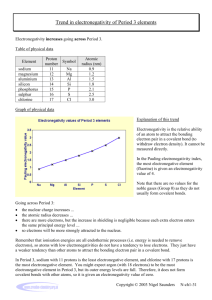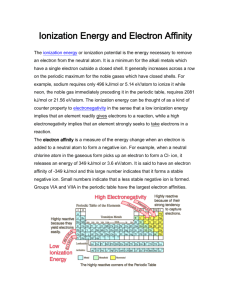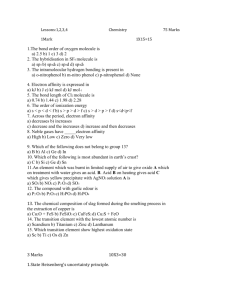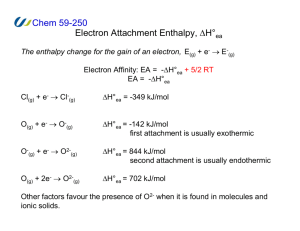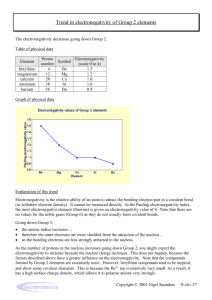Electron Attachment Enthalpy, ∆H
advertisement
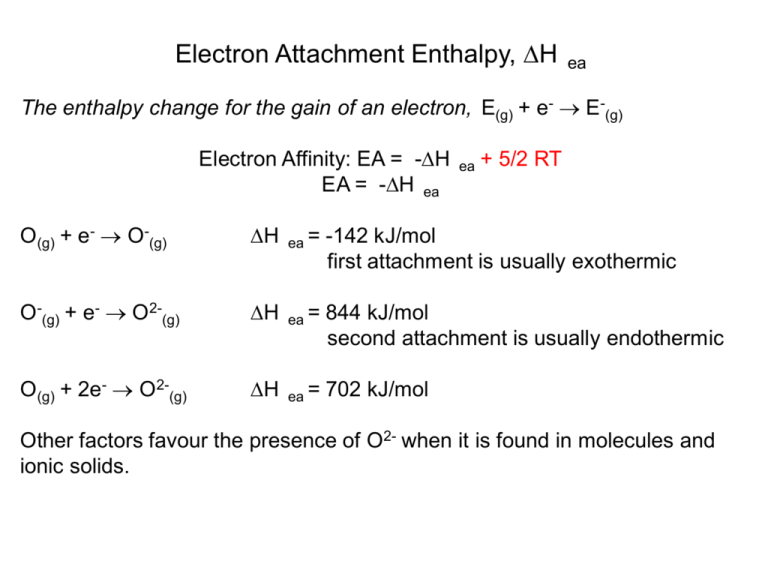
Electron Attachment Enthalpy, ∆H ea The enthalpy change for the gain of an electron, E(g) + e- → E-(g) Electron Affinity: EA = -∆H EA = -∆H ea ea + 5/2 RT O(g) + e- → O-(g) ∆H ea = -142 kJ/mol first attachment is usually exothermic O-(g) + e- → O2-(g) ∆H ea = 844 kJ/mol second attachment is usually endothermic O(g) + 2e- → O2-(g) ∆H ea = 702 kJ/mol Other factors favour the presence of O2- when it is found in molecules and ionic solids. Overall trends are not as apparent, however: EA decreases EA increases Highest values EA for halogens (Group 17) because the additional electron completes the shell. Negative values of EA for alkaline earth metals (Group 2) because the additional electron goes into the less-stable p subshell (smaller Z*). Negative values of EA for noble gases (Group 18) because extra electron has to go into next shell (n+1)s. → Na: [Ne]3s1 – additional electron makes [Ne]3s2 which is a full subshell. → Si: [Ne]3s2 3p2 – additional electron makes [Ne]3s2 3s3 which is a more stable half-filled subshell so EA is high. → P: [Ne]3s2 3p3 – additional electron makes [Ne]3s2 3p4 which requires electron pairing so EA is low. Electronegativity, X The ability of an atom in a molecule to attract electrons in a bond to itself. Linus Pauling X decreases X increases First Year rule ∆X > 2 : ionic 2 > ∆X > 0.5 : polar ∆X < 0.5 : covalent Traditional scale goes from 0 to 4 with X of F set to 4. Electronegativity, X (note: ∆Hd (A-B) = D(A-B)) Pauling’s definition: Pauling reasoned that the dissociation energy of a purely covalent bond A-B should be the mean of the dissociation energies for the homonuclear bonds A-A and B-B. Any additional energy must be caused by electrostatic attraction between A and B (attributed to ionic character in a bond). The ionic character must be related to the difference in the electronegativities of A and B. He calculated this difference as follows: D(A-B),theory = ½ (D(A-A) + D(B-B)) ∆’(A-B) = D(A-B),experimental - D(A-B),theory ∆’(A-B) is the ionic resonance energy in kJ/mol (∆(A-B) is in eV) XA – XB = 0.102 (∆’(A-B))½ A-B A+ B0.102 is a conversion from kJ/mol to eV An example calculation for H-F D(H-F),theory = ½ (D(H-H) + D(F-F)) = ½ (436 + 158) = 297 kJ/mol ∆’(H-F) = D(H-F),experimental - D(H-F),theory = 566 – 297 = 269 kJ/mol XF – XH = 0.102 (∆’(H-F))½ = 0.102 (269)½ = 1.67 Pauling set XF = 4.0 so: XH = 4.0 – 1.67 = 2.32 Note: 2.32 is different than the value of 2.2 you see in tables because Pauling used the geometric mean instead of the arithmetic mean. Similar calculations were used to determine X for the other elements. (∆(H-Cl) )½ = 0.98 eV relative to H so XCl ≈ 3.2 (∆(H-Br) )½ = 0.73 eV relative to H so XBr ≈ 2.9 (∆(H-I) )½ = 0.25 eV relative to H so XI ≈ 2.5 Electronegativity, X (note: ∆Hie A = IPA) Mulliken’s definition: Mulliken figured that the electronegativity of an element must be related to the energies of gaining and losing electrons. Specifically an atom that binds it’s electrons stongly (large ∆H ie) and gains other electrons readily (very positive EA or very negative ∆H ea) should do the same in molecules. Thus Mulliken calculated the electronegativity of an atom as the mean of the ionization potential and the electron affinity. For A-B, the electronegativity difference between A+B- and A-B+ is given by: Robert Mulliken XA – XB = ½ ([IPA + EAA] – [IPB + EAB]) XA = ½ ([IPA + EAA]) (these are then scaled to fit the ≈ 0-4 scale) This method makes a lot of sense, but is not used because values of ∆H have not been accurately determined for many elements. ea Electronegativity, X The Allred-Rochow definition: The assumption is that the force that will draw an electron toward an atom is proportional to the effective nuclear charge of that atom and related to the distance of the electron from the nucleus. Force = Z*e 4πε 0r 2 2 The equation: X = 0.359 (Z*/r2) + 0.744 puts the calculated values on the Pauling scale. This definition is useful because it can be applied to many more atoms and is one of the most used scales. Z* = effective nuclear charge e = charge of electron ε0 = permittivity of a vacuum r = atomic radius Electronegativity, X There are several other definitions based on different assumptions and methods, such as quantum mechanical calculations (Boyd) or spectroscopic measurements (Allen), but the values for elements usually end up around the same. Trends in electronegativities are similar to those found for ionization enthalpies. The trends in electronegativities and ionization enthalpies explain many features of chemistry such as the “diagonal relationship” (X) and the position of the metallic and nonmetallic elements (∆H ie). Electronegativity also lets us predict the polarity of bonds and chemical reactivity. δ+ δ− Si Cl δ+ δ− Si O δ+ δ− H O δ+ δ− H Cl Electronegativity lets us predict the polarity of bonds and explains differences in chemical reactivity. H H H C C C C + C C H − δ δ + 3 H Cl No Reaction H H H + δ H B H N N δ− H B N H B H + H − δ δ + 3 H Cl H N Cl B H H H Cl H N H B N Cl H B H We will examine the effects that electronegativity differences have on the bonding in compounds in much more detail later. X decreases, acidity increases Electronegativity also lets us predict the acidity of some binary element hydrogen compounds. Going down a group X decreases. This means that the conjugate base of X increases, acidity increases the acid have a lower charge density because the electrons are held less tightly. Because of this, the base has a lower attraction for H+ cations and the element-H bonds are weaker. E.g. (EO-H > ES-H > ESe-H) Thus the acidity of the compounds increases as we go down the table. Polarizability and Hard and Soft Atoms α increases The polarizability,α, of an atom is its ability to be distorted by the presence of an electric field (such as a neighbouring ion). The more easily the electron cloud is distorted, the higher α. This happens primarily with large atoms and anions that have closely spaced frontier orbitals (HOAO and LUAO). α decreases The hardness,η, of an atom is a related quantity. Hard atoms (high η) bind their electrons tightly and are not easily polarized. Soft atoms (low η) bind their electrons loosely and have a higher α. η= ½ ([IPA - EAA]) in eV ηSi ≈ 3.4 ηSn ≈ 3.0 ηF ≈ 7.0 ηI ≈ 3.7 Hard and Soft Ions The hardness,η, of an atom or ion can also provide us with information about the chemistry that will happen between different reagents. In general, hard acids tend to form compounds with hard bases and soft acids tend to bind to soft bases. Hard acids include transition metals and main group elements that are small and highly charged e.g. Li+, Mg+2, Al+3, Fe+3 Hard bases generally contain main group elements that are small and very electronegative e.g. F-, R-O-, NH3, ClSoft acids include transition metals and main group elements that are large and not as highly charged e.g. Tl+, Ag+, Pb+3, Fe+2 Soft bases generally contain main group elements that are large and weakly electronegative e.g. I-, SR2, AsR3, R-N≡C


